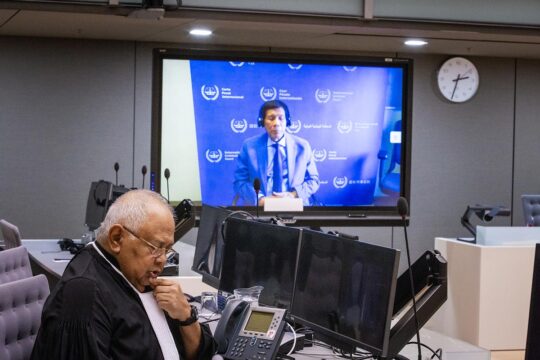In his decision, Judge Fernando Andreu Merelles underlines that the crimes committed in 1994 are of the ICTR jurisdiction and says he is ready to transfer the case to it. The ICTR did not officially react but
in session a member of the office of the prosecutor, answering to a lawyer who stated that the international court "was not concerned" with the Spanish decision.
If the prosecutor is not legally bound by the conclusions of the Spanish judge, it, on the other hand, is held, by several resolutions of the United Nations, including one issued in August 2003, to prosecute the
officials of the Rwandan Patriotic Front who would be guilty of crimes under the jurisdiction of the tribunal created by the UN.
Since, the prosecutor Hassan Bubacar Jallow holds his answer and explains that he is studying the results of the investigations started in June 2000 on this issue.
These investigations are officially closed since the end of 2004. While abstaining from answering on the attack of 6 April 1994, considered as the spark that led to the genocide, and taking into account the crimes committed by the rebels, then by the regime in power since they captured Kigali in July 1994, the prosecutor caused complaints to be filed and the opening of legal procedures before other jurisdictions, like France and Spain. Ten months before the end of the first instance trials he is also compromising the legacy of the tribunal.
In creating a standstill out of a part of the story, he, in particular, fed the arguments of persons accused of genocide in Arusha, who constantly denounce a political justice and see in each new procedure, whether it be in France or Spain, justifications for their own crimes. However, self-defence has never been accepted for the crime of genocide or crimes against humanity.
According to the Spanish judge, the facts relating to the RPF in 1994 are overpowering. Fernando Andreu Merelles explains why between August 1993 and March 1994, "the RPA/RPF planned the final attack to seize power by force". He considers the agreement signed 4 August 1993 in Arusha, which led the Rwandan Patriotic Army (RPA) to place a battalion of 600 men in the capital, as a mission to protect the officials of the Rwandan Patriotic Front.
The judge writes that the RPF took advantage of this period to bring military equipment and organize the entry of funds, train the men of the battalion and infiltrate the Hutu extremist organizations. The orders
were to attack the Rwandan armed forces, "knowing that their missions would not prevent the foreseeable massacre of Tutsis who did not leave the country in 1959", in the areas of Kibuye, Gikongoro, Gitarama,
Kubungo and in Bugesera.
The judge mentions the political assassinations of opponents, including, among others, that of Felicien Gatabazi, founder and president of the Social Democratic Party, 21 February 1994. "After each murder, massacres of Tutsis took place", writes the judge who examined the attacks in Gisenyi and Ruhengeri on 8 February 1994.
Merelles established that on 14 March 1994, the high command of the rebellion planned massacres in the regions of Byumba, Umutara and Kibumgo and adds that several meetings were intended to prepare the assassination of the former president Juvenal Habyarimana, 6 April 1994, which started the genocide of the Tutsis. Always in 1994, the judge writes that "in the diocese of Byumba (...) a sector completely controlled by the RPA/RPF (...) several thousand people were killed, including 64 Hutu priests".
Facts that the members of the ICTR special investigations unit investigated in depth, according to several sources. According to the Spanish decision, nearly 2 500 people, held at the stadium of Byumba,
were murdered and their "lifeless bodies were dumped in a septic tank" of a building belonging to Felicien Kabuga.
The judge, who bases himself in particular on the Gersony report, which had been classified confidential by the United Nations, mentions the massacre of almost 5 000 people at the border with Tanzania and of the
military capture of Gitarama, 2 June 1994, which resulted in the murder, in Kabgaye, of three catholic bishops and nine priests.
The judge estimates, on the basis of witness statements, at least 312 726 people were victims of the RPA, between July 1994 and 1995, and counts 173 mass graves in the country. All these elements are thus under the jurisdiction of the ICTR, without it being bound by the qualification given by the Spanish judge to these crimes.
If the judge prosecutes the officers for genocide, he does not bring, on the other hand, elements making it possible to conclude that the number of victims does not constitute a proof of genocide. Merelles
established, however, that the RPF target to dominate the country, and not to exterminate Hutus.
SM/MM/SC
© Agence Hirondelle



